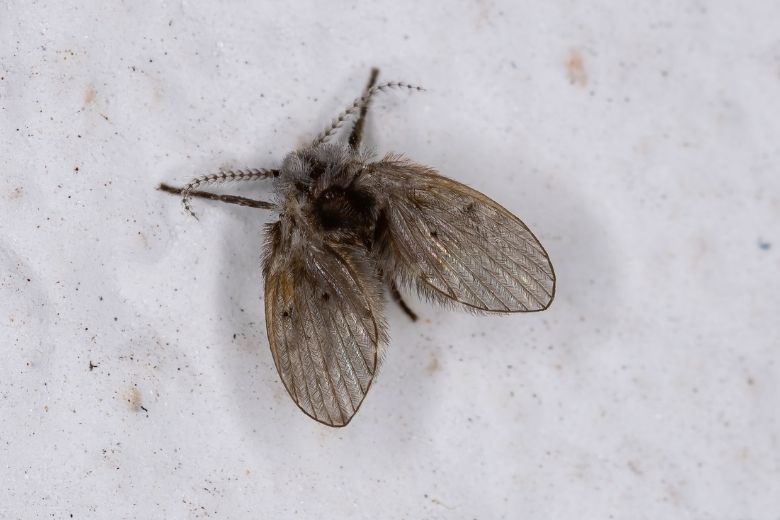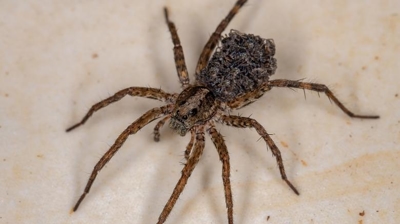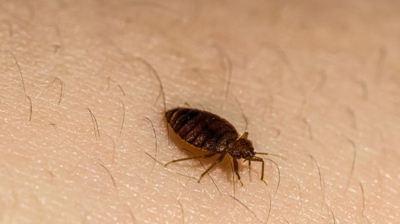
Drain Fly Control Services

Drain Flies
Drain flies, also known as sewer flies or moth flies (scientific name Psychodidae), can be considered harmful in several ways, primarily due to their presence in areas with poor sanitation or moisture, which can lead to various health and hygiene issues. Here are some key ways drain flies might be harmful:
- Disease Transmission: While drain flies themselves are not directly pathogenic, they can carry bacteria, fungi, and other microorganisms from contaminated environments (like drains, sewers, and garbage areas) to other parts of a home or business. When they land on food, utensils, or kitchen surfaces, they might indirectly contribute to the spread of illnesses, especially foodborne diseases.
- Allergic Reactions: Some individuals may develop allergic reactions to drain flies or their larvae. These reactions can manifest as respiratory issues, skin rashes, or other allergic responses, particularly in people with sensitivities or asthma.
- Nuisance and Discomfort: The presence of drain flies is a clear sign of poor sanitation, often indicating clogged drains or decaying organic matter in pipes or other wet areas. Their persistence can create an uncomfortable environment, making it difficult to maintain a clean and hygienic space.
- Property Damage: Drain flies lay eggs in organic matter, such as sludge, mold, or rotting food found in clogged drains or sewage systems. The presence of large numbers of drain fly larvae can lead to the degradation of organic material, potentially leading to unpleasant odors, water contamination, and even damage to pipes if left unchecked.
- Pest Infestation Indicator: An infestation of drain flies often signals an underlying issue with plumbing or drainage systems, which might need professional attention. If left unresolved, this can lead to more severe problems like mold growth, water damage, or an increase in other pests that thrive in damp environments.
While drain flies themselves are not major threats in terms of direct harm, they can be indicative of unsanitary conditions that could lead to health issues, property damage, and general discomfort if left unaddressed. Managing the source of infestation, such as cleaning out clogged drains and improving drainage systems, is essential to preventing further problems.
Learn more: Do Drain Flies Bite? || What Do Drain Flies Look Like?
Drain Fly Removal
Drain flies, also called sewer flies or moth flies, may seem harmless because of their small size and slow movement, but these flies are a significant concern for several reasons, particularly in homes and commercial settings:
- Health Risks: Drain flies are not just a nuisance—they can carry bacteria and other pathogens that contribute to the spread of disease. They breed in organic matter and standing water, particularly in drains, sinks, and sewage systems, picking up harmful microbes. While they aren’t known for biting, they can contaminate food preparation areas, utensils, and surfaces with bacteria like E. coli, Salmonella, and other opportunistic pathogens, increasing the risk of gastrointestinal and skin infections.
- Rapid Infestation: Drain flies reproduce quickly. A single female can lay dozens of eggs in a damp, organic-rich environment. These eggs hatch into larvae within days, which then mature into adults in about one to two weeks. Because they breed in hidden areas such as drains, sewage lines, or under floors, infestations can escalate rapidly if left unchecked, making eradication more difficult the longer it is ignored.
- Property Damage and Sanitation Issues: While drain flies themselves do not chew through materials, their presence is a signal of moisture problems or decaying organic matter, which can lead to structural issues like wood rot or mold growth. Chronic infestations can compromise the sanitary conditions of kitchens, bathrooms, and commercial facilities, potentially resulting in failed health inspections or liability concerns in businesses like restaurants or food processing.
- Nuisance Factor: Even at low numbers, drain flies can be very bothersome. They tend to gather around sinks, drains, and windows, often swarming in the evenings. Their presence can give the impression of a poorly maintained or unhygienic environment, which is especially problematic in restaurants, hospitals, or residential settings where cleanliness is critical.
- Indicator of Larger Problems: A drain fly infestation often signals a hidden problem, such as clogged or leaking drains, decaying organic matter, or standing water somewhere in the plumbing system. Ignoring the flies does not remove the underlying issue, and these problems can worsen over time, leading to more extensive repairs or sanitation concerns.
Effective removal is crucial not just to eliminate the immediate nuisance but also to address the source. This typically involves thorough cleaning of drains, removing organic buildup, repairing leaks, and sometimes using targeted larvicides. Simply swatting the flies or spraying them in the air addresses only the symptom, not the root cause.
Learn more: How To Get Rid Of Drain Flies
Drain Fly Control
Hiring our professional pest control for drain flies is often the smartest and most effective choice, especially when DIY methods don’t deliver lasting results. While home or business owners can attempt to clean drains, pour boiling water, or use store-bought drain gels, these solutions usually only address surface-level issues. Drain flies breed deep within organic buildup in drains, pipes, and hidden moisture pockets. If the root source isn’t fully eliminated, these flies will quickly return.
Our professional pest control services bring expertise, specialized tools, and long-term solutions that go beyond temporary fixes. Our technicians know how to locate the exact breeding sites—whether inside plumbing, floor drains, or even behind walls where moisture collects. We use safe, targeted treatments that break the life cycle of drain flies, ensuring both larvae and adults are eliminated.
Additionally, our professionals can identify underlying problems contributing to the infestation, such as leaking pipes, poor drainage, or structural moisture issues, and advise on preventative measures. This not only clears up the current problem but also reduces the risk of recurrence.
For businesses, hiring our professionals is even more critical. Drain fly infestations can damage reputation, especially in restaurants, hotels, and healthcare facilities. We provide discreet, efficient service that protects your brand while keeping your property sanitary and compliant with health standards.
Drain Fly Exterminators
Hiring our local exterminators for drain fly infestations provides several critical advantages over a national or large chain company, particularly when dealing with these small flies:
- Expertise with Local Plumbing and Environment: Drain flies breed in specific conditions—organic buildup, stagnant water, and moist drains. Our local exterminators have years of experience with the particular plumbing systems, pipe materials, and drainage patterns common in the area. We know exactly where these flies are likely to breed and which local conditions—like seasonal moisture issues or regional plumbing quirks—contribute to infestations. A national company will typically rely on standardized protocols that don’t account for these local nuances, potentially missing hidden breeding sites.
- Faster Response Time: Drain fly infestations can escalate quickly because of their short life cycle. Our local exterminators can often respond within 24-48 hours, whereas national companies may have to schedule appointments around centralized routing and logistics. Faster response means quicker control of the population, reducing the risk of it spreading to multiple drains or rooms.
- Tailored, Hands-On Treatment: Drain flies are notoriously difficult to eliminate because adult removal alone is ineffective; the larvae in drains must be fully eradicated. Our local professionals can inspect your specific plumbing system, physically remove organic buildup, and apply treatments in a targeted way. Large companies often use generalized treatments—like broad-spectrum sprays—that may reduce adults temporarily but leave larvae in the breeding grounds, leading to recurrence.
- Knowledge of Local Regulations and Products: Some chemical or biological control products are restricted or regulated differently depending on the state or municipality. Our local exterminators are up to date on what is legal, safe, and effective in the area. We also choose eco-friendly or low-toxicity products when possible, which is especially important in homes, restaurants, or healthcare settings. National chains often rely on a uniform set of products that aren’t optimized for your location.
- Cost Efficiency and Accountability: Our local exterminators provide a more precise, custom quote based on your actual problem. National companies typically charge for standardized packages, increasing cost without guaranteeing effectiveness. Additionally, our local team is highly motivated to maintain our reputation in the community, so we tend to be more thorough and accountable—we want long-term results and satisfied neighbors, not just a one-time visit.
- Long-Term Prevention and Education: Our local exterminators don’t just eliminate the current drain fly population—we identify the underlying causes and advise on preventive measures tailored to your property, such as plumbing modifications, proper drain maintenance, or moisture control strategies. National companies often stop at removal without providing detailed guidance on preventing recurrence, leaving you at risk of repeated infestations.
Our local exterminators combine hands-on inspection, precise treatment, quick response, and region-specific knowledge. For drain flies, which breed in hidden, persistent areas, this expertise significantly increases the likelihood of a permanent solution.
Where Are Drain Flies Found?
Drain flies are most commonly found in areas where organic material accumulates in moist, stagnant environments. Here are the places where you are most likely to encounter them:
- Drains and Pipes: Drain flies are typically found in kitchen, bathroom, and laundry drains, particularly in sink, shower, or bathtub drains where organic matter (like food particles, grease, soap scum, or hair) can accumulate. They thrive in the sludge and decaying organic material that can build up inside pipes, especially in areas where water tends to stagnate.
- Sewer and Septic Systems: Drain flies are often found near or inside sewer systems, septic tanks, and other areas with poor sanitation and high levels of organic matter. They may infest the vents or areas where the waste water backs up or leaks.
- Garbage Areas: If there's a buildup of waste or food scraps in trash bins, dumpsters, or compost piles, drain flies can be attracted to these areas. The decomposing organic material in trash provides a perfect breeding ground for the larvae.
- Basements and Crawlspaces: In damp or poorly ventilated areas like basements, especially those with plumbing leaks, you may find drain flies. These areas often have stagnant water or moisture that supports the growth of the organic matter drain flies need to thrive.
- Wet or Moldy Areas: Areas that are consistently damp, such as under refrigerators, washing machines, or other appliances, as well as places with mold growth, can attract drain flies. These environments provide the organic matter and moisture necessary for the flies to breed.
- Floors Near Leaking or Clogged Drains: Even when drains are not immediately visible or accessible, leaks around the base of toilets, bathtubs, or sinks, as well as areas with clogged or slow drains, can harbor drain fly larvae.
Drain flies are drawn to moist environments rich in decaying organic matter, so areas with poor drainage, high humidity, or plumbing issues tend to be hotspots. If you notice drain flies, it’s often a signal that there is some organic buildup or moisture problem in these areas that needs attention.
What Do Drain Flies Eat?
Drain flies primarily feed on decaying organic matter, which provides the nutrients they need to survive. Here's a breakdown of their diet:
- Decaying Organic Material: The primary food source for drain flies is the organic matter that accumulates in drains, pipes, sewers, and other moist environments. This includes food particles, grease, soap scum, hair, mold, and other organic debris. Drain flies are attracted to these areas because the decaying material provides a rich, steady food source.
- Bacteria and Fungi: Drain flies also feed on the bacteria and fungi that grow on decaying organic material. These microorganisms break down the organic matter, and the flies will feed on them as well, thriving in environments where bacterial growth is high.
- Slime or Biofilm: In areas with poor drainage, a biofilm or slimy layer can form on the sides of pipes, drains, or other surfaces. This biofilm consists of microorganisms, including bacteria, fungi, and algae, which drain flies feed on. It's essentially a thin film of decomposing matter, ideal for larvae to feed and develop.
- Mold: Mold and mildew, which grow in damp and humid environments, also attract drain flies. These fungi provide a source of food for both adult flies and larvae.
Drain flies thrive in environments where organic material has started to decay, as these areas provide both the food and moisture they need. While adult drain flies feed on microorganisms and decomposing matter, the larvae feed on the same material in the sludge and muck inside drains and pipes, helping them grow and develop.
Drain Fly Life Cycle
The life cycle of drain flies, also known as moth flies, follows a simple but distinct process, which typically spans about 8 to 24 days, depending on environmental factors like temperature and food availability. Here's a breakdown of their life cycle:
Eggs
- Location: Drain fly eggs are usually laid in moist, organic matter such as sludge in drains, pipes, septic systems, or in any decaying organic material like garbage or compost piles.
- Laying: A female drain fly can lay hundreds of eggs at a time. The eggs are typically deposited in clusters and are about 1 mm in length, white or translucent in color.
- Incubation: The eggs hatch within 24 to 48 hours under favorable conditions, typically in the warm, moist environments where the adult flies have been living.
Larvae
- Appearance: Drain fly larvae are small, white, worm-like creatures, about 1/4 inch (6 mm) long. They have a segmented body with a small, dark head.
- Feeding: The larvae feed on the decaying organic matter in which they were laid, such as the sludge inside drains, pipes, or garbage. They graze on microorganisms like bacteria, fungi, and algae that thrive in these environments.
- Development: Larvae go through several instar stages (growth phases), molting between each stage, and they typically take about 7 to 14 days to mature into pupae.
Pupae
- Transition Stage: After feeding, the larvae form pupae. During this stage, the larvae encase themselves in a cocoon-like structure made of debris and other materials from their environment.
- Duration: The pupal stage lasts about 2 to 3 days, during which the larvae undergo transformation into adult flies. This stage can be shorter or longer, depending on environmental conditions.
Adults
- Emergence: Once the pupae have fully developed, adult drain flies emerge. The adult flies are small, with fuzzy, moth-like wings, and they are often seen flying around drains, sinks, or other areas with excess moisture.
- Mating: Adults mate soon after emerging, and females begin laying eggs within 48 hours of mating. Adult drain flies generally live for about 2 weeks, but during this time, they can reproduce several times.
- Feeding: Adult drain flies feed on bacteria, fungi, and other microorganisms in their environment, often found in moist areas, but they do not feed on solid food like humans do.
This cycle can be completed in as little as 8 days, but in less favorable conditions, it may take longer. The cycle repeats, and as long as there is a consistent supply of organic matter and moisture, drain fly populations can grow rapidly. Regular cleaning of drains, proper sanitation, and addressing plumbing issues are crucial to controlling their reproduction.

Hear From Our Happy Customers
-
"Great Communication"
Tech was on time, communication was great, and he accommodated my needs.
- Alonzo W. -
"Very Knowledgeable"
The tech that arrived was courteous, professional, and very knowledgeable. He was Great.
- Uerial I. -
"Exceeds Expectations"
I can’t say enough positive things about this company... The tech that came out, Jarvis went above and beyond my expectations. Thank you guys, I will continue using your services.
- Jake M. -
"Wonderful Service"
Wonderful service. Jarvis is great. Took care of everything I needed. Thank you!
- Henry P. -
"Professional & Considerate"
I’m pleased with Miche services. Jarvis came today. Professional and considerate. Thank you!
- Judy B. -
"Fantastic & Patient"
Jarvis was fantastic and patient. He answered my questions with an in-depth explanation and addressed all of my areas of concern. Would love for him to be my assigned tech going forward. Well done!
- Yonnette M.



